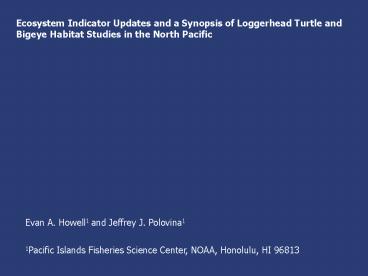Evan A' Howell1 and Jeffrey J' Polovina1
1 / 35
Title: Evan A' Howell1 and Jeffrey J' Polovina1
1
Ecosystem Indicator Updates and a Synopsis of
Loggerhead Turtle and Bigeye Habitat Studies in
the North Pacific
Evan A. Howell1 and Jeffrey J. Polovina1 1Pacific
Islands Fisheries Science Center, NOAA,
Honolulu, HI 96813
2
Contents
Show status of our Ecosystem Indicators (EOF,
TZCF, Monk Seals Habitat, new indicators in
progress) Show results of our work with
loggerhead turtles in the KECBR Talk about our
work on bigeye tuna habitat Publications/Future
Work
3
Ecosystem Indicators
4 Boxes Used Equatorial 120E-80W,20S-20N Centra
l120E-140W,20-45N Eastern135-100W,20-65N Nor
thern 155E-120W,45S-65N
Basin
4
Ecosystem Indicators
- Equatorial Region
- Good El Niño Indicator
- e.g. Strong 1998, weak 2003, 2005?
5
Ecosystem Indicators
- Central North Pacific
- Captures dynamics of Subtropical Gyre
- Large La Niña shift in 1999, came down in 2002
with El Niño signals in early 2003 and 2005
6
Ecosystem Indicators
- Eastern Pacific
- Captures California current
- El Niño effects of 1998 and 2003 almost same in
magnitude, no real signal in 2005
7
Ecosystem Indicators
- Northern Pacific
- Shift in 1999
- El Niño effects in 2003 and 2005
8
Ecosystem Indicators
9
Ecosystem Indicators
Transition Zone Chlorophyll Front (TZCF) Basin
wide feature with 1000 km north-south
migration Southern minimum FebruaryNorthern
maximum August Boundary hi surf chl lo
chl TZCF represent key migration and forage
habitat for turtles, albacore tunas, and other
predators
10
Ecosystem Indicators
11
Ecosystem Indicators
Survival prediction based on Chl a index Only
able to go back to September, 1997
12
Ecosystem Indicators
Average across 180-160W
13
Ecosystem Indicators
Survival based on SST Can go back to
1984 Juvenile survival (top) dependent on
southern position of SST/TZCF front (2 year lag
in indicator) Pups born in 2001-2003 show
decline in survival Should see increase in
survival based on indicator rise from 2004 12
yr old Lisianski/PHR/Midway/Kure 34 yr old
PHR/Midway/Kure
14
Contents
Show status of our Ecosystem Indicators (TZCF,
EOF, Monk Seals Habitat, new indicators in
progress) Show results of our work with
loggerhead turtles in the KECBR Talk about our
work on bigeye tuna habitat Publications/Future
Work
15
Loggerhead Turtles
16
Track lines for juvenile loggerhead turtle
releases
Central North Pacific releases
Japan releases
17
Frequency distributions of loggerhead turtle
residence for CNP releases (A) and Japan releases
(B)
Found common areas where both sets resided (KECBR)
18
Schematic of the Kuroshio Extension Current
Bifurcation region (A)
AVISO altimetry for March 2003
AVISO altimetry for September 2003
19
MODIS primary productivity (BF model) for Quarter
1 2003
MODIS primary productivity (BF model) for Quarter
2 2003
MODIS primary productivity (BF model) for Quarter
3 2003
MODIS primary productivity (BF model) for Quarter
4 2003
20
Loggerhead track over SSH and geostrophic
currents for October 2003 (A), November 2003 (B),
December 2003 (C), and January 2004 (D)
21
Loggerhead track over SSH and geostrophic
currents for July 2003 (A), August 2003 (B),
September 2003 (C), and October 2003 (D)
22
Geostrophic currents and ocean color for
September 6-13, 2003
Geostrophic currents and ocean color for March
5-12, 2004
23
Juvenile Loggerhead Migration Schematic and the
KECBR
KECBR
Area between 155ºE and 180 important forage
habitat for juvenile turtles and other pelagics
(bluefin tuna)
24
Contents
Show status of our Ecosystem Indicators (TZCF,
EOF, Monk Seals Habitat, new indicators in
progress) Show results of our work with
loggerhead turtles in the KECBR Talk about our
work on bigeye tuna habitat Publications/Future
Work
25
Refining light-based pop-up archival tag tracks
using the KFSST package
- We use pop-up satellite archival tags to get
subsurface information on pelagics (bigeye/opah) - Tags give light based locations but there are
problems with latitude (time at surface, equinox) - We can use satellite data to remove dependence on
light for latitude (longitude est. are good) - Kalman filter state-space model KFSST
- Sibert et al., 2003 Musyl et al., 2001 Sibert
et al., 2001
26
KFSST methodology
Model is tuned to find SST values from satellite
matched to TAG temperature values (average lt15 m
in 24 hours) (directed movement and random walk
components)
27
What we end up with
From initial information
Get scattered light-based measurements
Large improvement by using KFSST Bigeye highly
migratory species???
28
KFSST future - Opah
Opah do not come to surface, yet cross 100 m
depths Substitute temperature at 100 m for
surface (WOA climatology, model data)
29
What we end up with
Matched temperature from 90-100 m to WOA
climatology Working to incorporate model data
into KFSST
30
Contents
Show status of our Ecosystem Indicators (TZCF,
EOF, Monk Seals Habitat, new indicators in
progress) Show results of our work with
loggerhead turtles in the KECBR Talk about our
work on bigeye tuna habitat Publications/Future
Work
31
2005 FATE Publications
Polovina, J. J., I. Uchida, G. Balazs, E. A.
Howell, D. Parker, P. Dutton. Submitted. The
Kuroshio Extension Current Bifurcation Region A
pelagic hotspot for juvenile loggerhead sea
turtles. Deep Sea Research Howell, E. A. and D.
R. Kobayashi. Accepted w/revisions. El Niño
effects in the Palmyra Atoll region
Oceanographic changes and bigeye tuna (Thunnus
obesus) catch rate variability. Fisheries
Oceanography Polovina, J. J., and E. A.
Howell. 2005, Ecosystem indicators derived from
satellite remotely sensed oceanographic data for
the North Pacific. ICES Journal of Marine
Science, 62319-327.
32
Future work
Work with model data (Fei Chai) Incorporate
with KFSST model EOF analysis of biological
parameters to assess variation Continue work on
bigeye tuna Continue work in KECBR region
(bluefin tuna)
33
(No Transcript)
34
Frequency distributions for loggerhead turtles
released from Japan by latitude
35
Frequency distributions for loggerhead turtles
released from the central North Pacific by
latitude































